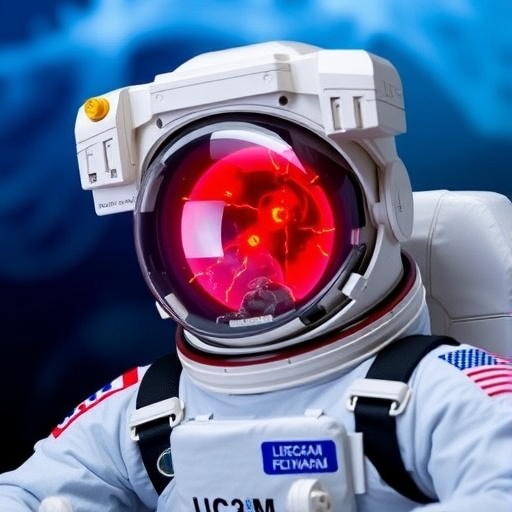In a groundbreaking initiative, an international consortium of esteemed female scientists has embarked on an innovative research project, aiming to examine and mitigate the detrimental effects of microgravity on the human body. The project, spearheaded by the Spanish Space Agency (AEE) and featuring staff from the Universidad Carlos III de Madrid (UC3M), recently concluded its parabolic flight campaign in Bordeaux, France. This research not only tackles a significant hurdle in human space exploration but could also pave the way for breakthroughs in health care on Earth, particularly regarding cardiovascular conditions.
Leading the pioneering study is Professor Ana Díaz Artiles, who serves at Texas A&M University (TAMU) in the USA while also holding an honorary professorship in UC3M’s Department of Aerospace Engineering. The primary objective of the research is to develop countermeasures to safeguard astronauts’ cardiovascular and ocular health during extended missions, such as those proposed for lunar and Martian exploration. Through her deep expertise, Professor Díaz Artiles emphasizes the dual significance of this endeavor: it stands to enhance future space travel while simultaneously offering potential applications in treating vascular diseases on our planet.
The team assembled for this ambitious project is notable not only for its expertise but also for its diversity, featuring a significant representation of women within the scientific community. Among the distinguished members are Sara García Alonso, a reserve astronaut for the European Space Agency (ESA), Isabel Vera Trallero, who directs the Office of Space and Society at AEE, and Beatriz Puente-Espada, the head of the Aerospace Medicine Training Center (CIMA) for the Air and Space Force. This diverse cadre, further enriched by the participation of Professor Óscar Flores Arias from UC3M and graduate student Huc Pentinat Llurba from TAMU, underscores the collaborative efforts spanning national borders with involvement from the National Institute of Aerospace Technology (INTA).
A prominent focus of the research lies in understanding the alarming physiological challenges faced by astronauts during prolonged missions in microgravity. The absence of gravitational forces leads to an unsettling redistribution of bodily fluids, causing them to pool toward the head. This phenomenon can manifest as visual impairments, elevated intracranial pressure, and an increased susceptibility to blood clots in the neck. Such issues underscore the critical need for effective countermeasures that can be implemented ahead of ambitious missions to destinations like Mars.
One standout technique tested by this international team is known as Lower Body Negative Pressure (LBNP). This innovative approach functions by applying negative pressure to the lower limbs, successfully redistributing fluids back to the lower body and helping to restore normal circulation patterns. The adoption of LBNP not only promises to alleviate symptoms inherent in microgravity but is also heralded as a potential technique to enhance health care outcomes for patients dealing with similar circulatory challenges on Earth.
The real value of this project lies in the empirical testing of LBNP within genuine microgravity conditions aboard parabolic flights. This enables researchers to evaluate the efficacy of the technique in real-time, enticingly leading to the possibility of valid, applicable results pertinent to astronaut health. Oscar Flores, another key contributor to the study, enthuses about this critical evaluation, noting the significance of assessing such a promising method in authentic conditions as it could hold life-altering potential for both astronauts and terrestrial patients alike.
Throughout the course of the parabolic flight, scientists meticulously monitored a series of cardiovascular and ocular parameters to gauge the effectiveness of the LBNP technique. This research endeavor embodies a collaborative effort that draws together prominent figures in scientific inquiry from various prestigious institutions across the globe, including notable partners such as the University of California, Davis, and the University of Florida.
The funding for this research project comes from an impressive array of esteemed organizations, including the ESA, NASA, TAMU, and Lockheed Martin Corporation. Such robust funding underscores not only the international collaborative spirit inherent within this initiative but also highlights the substantial importance attributed to advancing human health in space exploration.
The potential ramifications of these findings extend far beyond the immediate scope of astronaut health; they hint at the promising future of preventative strategies for vascular diseases on Earth. By understanding the physiological changes elicited by microgravity, researchers can adapt and design interventions that may eventually be revolutionary in treating patients with compromised cardiovascular health.
As an acute interest in space exploration continues to burgeon, research initiatives like this one are crucial. They not only pave the way for sustainable human exploration of distant celestial bodies but also create pathways for innovations that can leap back to Earth, enhancing our understanding of health and disease while contributing to a more equitable and diverse scientific community.
With momentum gathering behind this paradigm-shifting project, the imminent findings are anticipated to generate excitement within both the scientific community and the public. As Professor Ana Díaz Artiles and her distinguished team forge ahead, their research serves as a reminder of the profound intersection between space exploration and the continuous quest for medical advancement, shining a light on the innovative spirit that fuels human potential.
This remarkable project illustrates the evolving landscape of space research and the increasingly critical role that gender diversity plays within this domain. As women step forward and take leading roles in scientific inquiry, the contributions they make not only propel the advancements in technology and health care but inspire future generations to pursue careers in these vital fields. The future of space travel may indeed hinge on the insights gleaned from such team efforts.
Subject of Research: Human health in microgravity
Article Title: Groundbreaking Research Sheds Light on Counteracting Microgravity Effects on Astronaut Health
News Publication Date: October 2023
Web References: [Link to publication or article, if available]
References: [Any cited references, if applicable]
Image Credits: Ana Díaz Artíles




